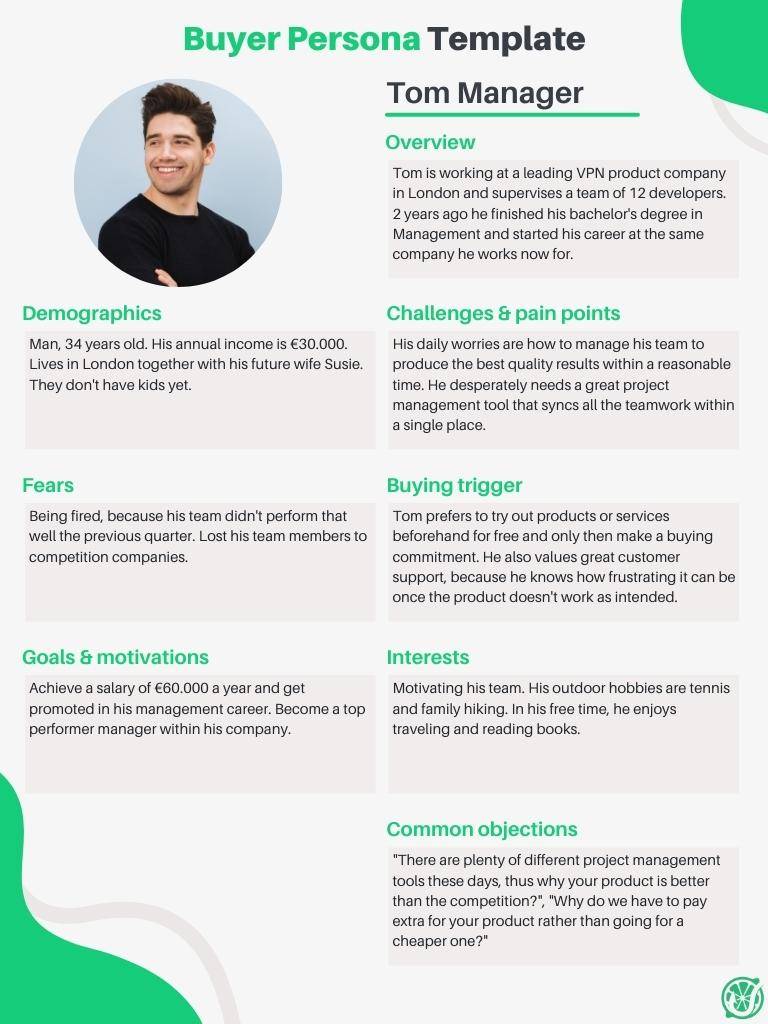
Every business, small or big, local or global is striving to increase its website traffic, leads, and sales.
Unfortunately, each year that becomes to do harder and harder, because more new companies enter the market. Next to that, the online space becomes even more cluttered with ads and branded content. It has been roughly estimated that an average Joe each day sees between 4,000-10,000 ads, both online and in the real world.
Just think for a second, that to target everyone would be simply stupid, to say the least, and nobody would hear your message. Because every person has different needs, pain points, and challenges. Thus brands must understand that, and tailor the brand message to the audience’s needs, goals, and motivation.
Thus, the question is, how do you make sure that your brand message reaches the right people, without burning the ad budget for nothing? In other words, how do you define which is the right target audience for your brand?
Creating buyer personas is the way to go and it allows brands to define their target audience, this way tailoring their brand message that matches their needs.
As the result, our main goal today is to help you better understanding what are the buyer personas and benefits of creating them. Further, we’ll create buyer personas for your brand in 5 simple steps.
Lastly, stick till the end, because in our Bonus part we’ll share several creative ways how you can make use of your newly created buyer personas.
Buyer Personas in Marketing
What’s a buyer persona?
To simply put it, a buyer persona is a semi-fictional recreation of a character that represents the ideal customer you want to do business with.
It’s semi-fictional because to create effective buyer personas you have to put lots of carefully planned work. For example, you have to research the market, analyze internal clients database, or organize a local interview to collect data about potential users.
In short, building buyer personas is the process that requires answers to the following questions about your potential customers:
- How old they’re? Where do they live and what is their marital status?
- What are their life and career goals?
- Do they have hobbies or other interests?
The following data helps brands to tailor their brand message and talk to the right customers the way they want to hear. As the result, the brand message should interest them, solve their problems, pain points, and show them a vision they want to see.
What’re the main types of buyer personas?
Buyer personas can be categorized into B2B, B2C, and negative personas.
B2B personas
If you’re dealing with B2B personas, defining these types of customers can become quite complex. The main reason for this is that these people usually blend with the traits and types of businesses they usually serve, thus it’s much more complicated to uncover their true intents, needs, and motivations.
B2C personas
On the other hand, if you’re in the B2C market, then you’re dealing with the final buyer of the product or service. Differently from B2B personas, these people want to satisfy their needs, desires and solve their problems.
Negative personas
Lastly, negative personas represent a group of people that are least likely to become purchasers of your product. Brands should create negative personas to easier recognize groups of people that aren’t interested in their product or service and save marketing budget by ignoring them.
What’re the benefits of defining buyer personas?
Next to the reasons mentioned earlier, building buyer personas for your brand could be helpful for various reasons.
To begin with, knowing your buyer personas brands can build brand advocates. These are Instagram or TikTok influencers, that have large audience of followers and can influence them in one or another way. It can help brands leverage the online space by asking influencers to share their brand message and products online. If these people grow with the brand and become loyal to them, they can become quite a powerful marketing tool, that strengthens brand’s social media presence.
Knowing your buyer personas can improve brand message to the public. Having data on how your customers behave and communicate, brand can build communication style guides, that help the employees make a better connection with the customers and help them when they need it the most.
Furthermore, brands that have defined buyer personas have a much smoother internal department communication, especially between marketing and sales departments. Knowing buyer profiles allows them to better synchronize these two departments and share important information that tells how the customers go through the entire product marketing funnel and convert them to the clients.
Lastly, brands that have defined buyer personas more effectively communicate to these people and convert them to clients. As the result, this data allows brands to precisely know how to find their customers, where they consume information, and what YouTube channels they like to watch. In the end, that saves brands valuable marketing resources and effectively increases their marketing campaign’s ROI.
5 Simple Steps to Create a Buyer Persona
To create buyer personas you can’t simply rely on the assumptions alone. This process requires hard work to research the market, analyze internal databases, create buyer personas, and share them across the team.
Let’s take a closer look at each step.
1. Scan your internal client’s database
To begin with, long-established brands have advantage over newly created ones, because they will have bigger databases of existing customers. As the result, first step would be to go through your internal client’s database.
If you store customers’ data through CRM software, analyze it. Search for repeating patterns, maybe the majority of your customers are from the same region, or maybe most of them are interested in sports. Compile all the repeating data that will be helpful later to create buyer personas.
Then analyze your analytics tools. If you’re using Google Analytics, evaluate received data. Analyze where your traffic is coming from, what keywords they use to find your business, or how long they spent on your site. Again look for repeating patterns and note all the changes within the data.
Lastly, this step most companies tend to forget, but that could be really valuable information. If you think, most of your employees deal with the clients day to day, thus they’re a great source of valuable information. Make use of this data and interview your employees working closest to them. Ask them what they found working with the clients, document the repeating patterns, and store that information for later purpose of creating buyer personas.
2. Perform a marketing research
Furthermore, next step takes more marketing resources, including time and money. That’s performing market research. Invite industry experts for a talk and let them share their experience of working with similar people to your buyer personas.
Create landing pages, or interactive quizzes and share them on social media channels. Ask people to answer them and have a chance to win some free goodies. If the marketing budget allows, think about outsourcing the market research to third-party agency that will do all the hard work for you and get back to you with raw data. Which later will be helpful to define your buyer personas.
Lastly, think about organizing customer surveys. Prepare a short questionnaire with relevant questions about potential clients’ demographics, personal information, interests, and challenges.
Ask questions such as:
Demographics:
- Where do you live?
- Where do you work and for how long?
- What’s the size of the company?
Personal information:
- What are your life goals?
- What day-to-day responsibilities do you have?
- Do you have challenges at work?
Interests:
- What social media channels do you like to use?
- What hobbies do you have?
- How do you learn new skills?
Challenges:
- How do we help you solve your problems?
- Do you usually solve problems yourself or ask for professional help?
- What challenges did you have before coming to us?
Organize short interview sessions around your region and expand the radius once that’s possible. Invite as many people as the budget allows because there’s no limit for that. Collect all the relevant information that will help you to build buyer personas.
Lastly, interview different types of people and don’t invite only your brand fans. As the result, inviting customers that aren’t that passionate about your brand will reveal great information about your weak points and what you should focus on.
3. Organize collected data
Once the research phase is over, it’s time to organize all the gathered data into segments.
Search for common characteristics and repeating patterns in your data. Analyze what interests, problems, and challenges were mentioned the most. This will help better understand what message and marketing content you should create to reach your buyer personas.
In this step, define how many buyer personas you want to have. Of course, that highly depends on how much data have you collected during your research phase. The more personas you’ll want, the more diversified your targeting will be. Though, be aware that for every new customer’s category you’ll have to make dedicated content. Thus, evaluate your marketing resources before deciding on how many buyer personas you’ll have.
4. Create a buyer persona
Once you’ve done research and organized data, it’s time to build your buyer personas.
There are several simple steps you should take while creating them and let’s take a look at each step.
Overview
Create a few short paragraphs that broadly define your buyer personas. In other words, that’s a summary of each section from the list.
Demographics
In this section include the summary of where your buyer personas are coming from. Where they grew up, where they live now, how old they are, or how many kids have.
Challanges and pain points
That’s a summary of all the problems buyer personas experience on the daily basis, what they’re struggling with and what are their main worries. Don’t forget to briefly touch on their needs.
Fears
In this section define buyer persona’s biggest fears and what failure means to them.
Buying trigger
That’s a summary of what triggers them during the buying process. It can be something as simple as buying a new car to show off against their neighbors or seeing a billboard ad on the way home from work.
Goals and motivations
In this section define your buyer persona’s career and personal goals. It could be something along the lines of learning a new skill that will increase their value at the company, resulting in better salary. Add everything that motivates them daily and wakes them up in the morning to get started with their day.
Interests
Here add all their interests and hobbies. Do they love watching late-night documentaries? Add it here. Are they a big fan of the Los Angeles Lakers basketball team, mention that here. It can be something they like to do themselves, but it can also be something they’re doing together with a group of people.
Common Objections
In this section include all the possible objections your marketing or sales team might encounter while communicating with your buyer personas. That can be objections such as too high price or some missing product features. Later this information will be helpful for your internal team to better prepare for client sale calls.

(Tom buyer persona example template)
5. Share buyer personas with the team
Once you’re done with your buyer personas, it’s time to share them with your team internally. Stick the printed buyer personas all around the office, create a kick-off meeting or invite real people similar to your heroes and interview them this way.
However, don’t ignore this important step, and synchronize buyer personas with all your team. That will help everyone to be on the same page while dealing with the clients, their problems, and give valuable suggestions to better approach each client’s case.
Lastly, the team that is better aware of their buyer personas will be more effective in creating the right content that sticks to the right people.
Bonus Point
Where to Use Buyer Personas
Once you’ve developed buyer personas and shared them with the team you might be asking where to use them. These are some creative ideas that will help you to get started.
1. Use buyer personas for content creation topics
Knowing all information about your buyer personas collected during the research phase will be extremely handy for your content creation. Since you already know your customer’s struggles and what questions they’re trying to answer, using this information is a great start to building your content calendar.
Think of different content topics that solve people’s problems. Convert them into blog posts, podcasts, videos, social media posts, email marketing campaigns, and much more.
2. Use buyer personas to enter new markets
If you’re planning to enter new markets, creating buyer personas can help you to evaluate new markets you’re entering. However, evaluate the existing buyer personas and make sure you need new ones only once they will be different from the rest. The process remains the same. Go through the market research, organize the data, look for repeating patterns and create buyer personas.
3. Use buyer personas during the content creation process
Keeping your buyer personas on top of the mind can be helpful during content creation process. Some marketers tend to print out buyer personas templates, that help them to think about target people’s needs and problems while creating content.
On the other hand, understanding your customer’s needs, goals, and challenges allows you to better deliver your brand message via content creation that speaks directly to their needs.
Conclusion
In conclusion, if your company is experiencing poor advertising results, or your website traffic, leads and sales aren’t that great it can be that you’re targeting the wrong people.
Thus reevaluate your buyer personas, or if you don’t have them yet, make them a top priority to have.
And believe me, knowing your buyer personas will improve your marketing results. As the result, you’ll have a better understanding of their needs, goals, and motivations that drives them forward. And most importantly what makes them buy and become your customer.
In addition, you can follow these 5 simple steps to create buyer personas for your brand:
- Scan your internal customer’s database such as data from CRM
- Perform market research, invite industry experts and organize local interviews
- Organize gathered data and look for repeating patterns. Create segmented user data
- Using organized data create buyer personas
- Share newly created buyer personas with your team internally
Lastly, make sure to understand your ideal customers, because that’ll improve your content quality, it’ll be easier to enter new markets and your team will be more synchronized during content creation process.
And most importantly, your marketing resources will be spent much more effectively. You’ll stop wasting time and money on broken campaigns and laser focus your marketing efforts on techniques that generate results.




